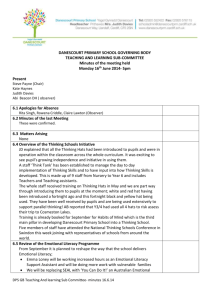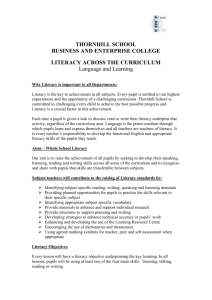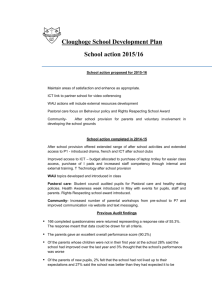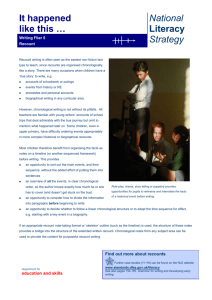Writing Flier 6: Instructions
advertisement
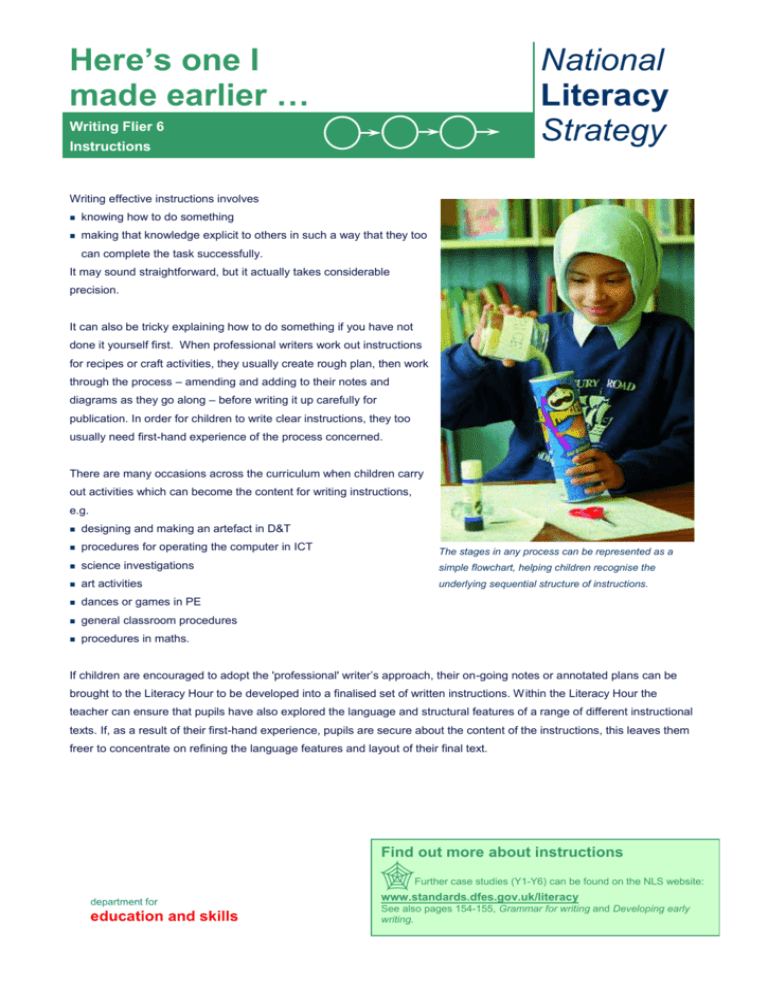
Here’s one I made earlier … National Literacy Strategy Writing Flier 6 Instructions Writing effective instructions involves knowing how to do something making that knowledge explicit to others in such a way that they too can complete the task successfully. It may sound straightforward, but it actually takes considerable precision. It can also be tricky explaining how to do something if you have not done it yourself first. When professional writers work out instructions for recipes or craft activities, they usually create rough plan, then work through the process – amending and adding to their notes and diagrams as they go along – before writing it up carefully for publication. In order for children to write clear instructions, they too usually need first-hand experience of the process concerned. There are many occasions across the curriculum when children carry out activities which can become the content for writing instructions, e.g. designing and making an artefact in D&T procedures for operating the computer in ICT The stages in any process can be represented as a science investigations simple flowchart, helping children recognise the art activities underlying sequential structure of instructions. dances or games in PE general classroom procedures procedures in maths. If children are encouraged to adopt the 'professional' writer’s approach, their on-going notes or annotated plans can be brought to the Literacy Hour to be developed into a finalised set of written instructions. Within the Literacy Hour the teacher can ensure that pupils have also explored the language and structural features of a range of different instructional texts. If, as a result of their first-hand experience, pupils are secure about the content of the instructions, this leaves them freer to concentrate on refining the language features and layout of their final text. Find out more about instructions department for education and skills Further case studies (Y1-Y6) can be found on the NLS website: www.standards.dfes.gov.uk/literacy See also pages 154-155, Grammar for writing and Developing early writing. Linking Science work on ‘Sound’ to D&T, a class of Year 5 pupils design and make their own musical instruments. 1 2 Children’s design plans, before they begin work on As they make their instruments, the children amend, annotate and add to these their instruments, consist of: skeleton plans in another colour, providing a record of the design process. a projected list of requirements a rough diagram of the intended outcome a flowchart of the stages they intended. Meanwhile, in the Literacy Hour, they study examples of instruction text, concentrating on layout and design features characteristics of instructional language, especially the use of the imperative and the way adjectives and adverbs are employed for precision rather than descriptive effect. In shared writing, their teacher demonstrates how to expand a set of skeleton notes into instructional writing, drawing particular attention to the sentence features they have investigated. department for education and skills 3 When the children’s instruments are complete, they expand their own skeleton notes into instructions on How to 4 Make A Musical Instrument, aimed at younger children. How to make a shaker You will need: A Pringles box 2 handfuls of dried peas or rice a few sheets of A4 paper glue paint glitter shiny coloured paper scissors varnish a coloured drawing pin 1 Make sure the inside of the Pringles box is dry. Then put in the dried peas or rice, and put the top on. 2. Put paper round to cover the Pringles box. Mark it to show where to cut, then cut it out and stick it on to cover up all the writing. 3. Trace round the box top with paper and carefully cut out the circle. Stick it on the top. 4. Paint the box a bright colour. Then leave to dry. 5. Decorate the shaker with glitter. Cut some strips of shiny paper to stick on the top. Stick them on firmly with glue and the coloured pin. 6. Varnish and leave to dry. NB: Audience = young children, so the author has chosen simple vocabulary and sentence structures. Making notes for instruction writing Instruction text usually requires four elements: statement of what is to be achieved list of items required diagram or diagrams sequential steps showing procedural sequence. A flowchart can clearly indicate the key stages in the sequence. Children should be encouraged to summarise each stage in note form. Flowcharts can also incorporate pictures and diagrams. Other possible procedural skeletons are timelines and storyboards. Children could make brief notes/diagrams on Post-it notes, one per stage, and stick them in sequence, or do the same with cards along a washing line. department for education and skills Two children discuss their notes and compose on screen. A younger class tries them out, and provides feedback on their effectiveness. National Curriculum and NLS Objectives PLANNING PROGRESSION in writing instruction text Year 1 Term 1 T16 Objective: Write and draw simple instructions for everyday classroom use. Example Shared writing: Teacher demonstrates how to write an illustrated instruction (e.g. ‘Put the scissors here. ‘). Individual/guided work: Pupils in pairs write/illustrate further instructions for classroom procedures. Year 2 Term 1 T15-18 Objective: Write simple instructions, organized sequentially, using diagrams and appropriate register. Example Shared writing: Teacher demonstrates how to write instructions for an activity pupils have done. Individual/guided work: Pupils write own instructions for another experience, based on writing frame devised from teacher’s model. Year 3 Term 2 T16, 17 Objective: Write instructions using a range of organisational devices (and using writing frames); make clear notes… Example Shared work: Teacher demonstrates how to make a puppet, compiling flowchart notes at each stage; then shows how to convert these notes into an instructional poster. (Create poster writing frame.) Individual/guided work: Pupils write own flowchart notes as they make their own puppets; then write own instructional posters based on teacher’s model. The NLS objectives link with and support work in the rest of the curriculum in several ways. We can: Bring content knowledge and reading/writing activities from the curriculum into the Literacy Hour. Work in the Literacy Hour is then linked to real purposes for reading, writing, speaking and listening. Teach language and literacy in both the Literacy Hour and other subjects, weaving the work in subjects and the Literacy Hour explicitly together. Apply and practise the skills learned in the literacy our in new contexts in the rest of the curriculum. Use language work done in other subjects to access children’s English abilities. Linking QCA Units of Work and NLS Writing Objectives In order to help with planning, links have been mapped between NLS objectives and existing writing activities within QCA schemes of work for history, geography, science, religious education and design and technology. Visit the QCA website: www.qca.org.uk/ca/subjects/english/literacy Year 4 Term 1 T25, 26 Objective: Write clear instructions, using link phrases and organisational conventions. Example Shared work: Instructions for ICT. Teacher models how to make flowchart notes at each stage of an ICT process, and how to convert these into clear instructions based on models drawn from reading. Individual/guided work: Pupils in pairs create notes for other ICT processes, to make a class handbook. Year 5 Term 1 T25 Objective: To write instructional texts and test them out. Example Shared work: Creating a book of playground games for young children. Teacher demonstrates how to write instructions for a game (play it, making notes, convert into instructions ) . Individual/guided work: Pupils in pairs follow same process to write instructions for inclusion in the book. Year 6 Term 3 T22 Objective: Select appropriate style and form to suit a specific purpose and audience, drawing on knowledge of different non-fiction text types. Example Shared work: Teacher (1) models how to select appropriate non-fiction text type for a piece of writing; (2) revises how to plan and write that text type, depending upon purpose and audience. Individual/guided work: Pupils, given audience and purpose, select style and form for a range of pieces of writing, and plan and write one piece. With thanks to staff and children of Salisbury Road Junior School, Plymouth and Hoyland Market Street School, Barnsley. DfES Publications Fax 0845 60 333 60 e-mail: dfes@prolog.uk.com © Crown copyright 2001 Tel 0845 60 222 60 Textphone 0845 60 555 60 Ref: DfES 0532/2001 Produced by the Department for Education and Skills This document may be reproduced for non-commercial or training purposes on the condition that the source is acknowledged. department for education and skills department for education and skills
